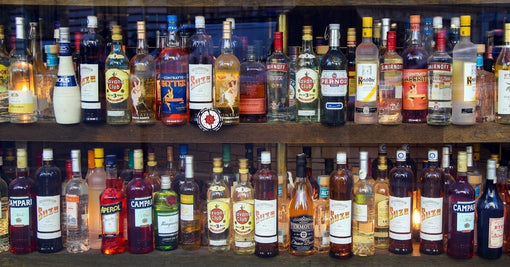

- Article published at:
- Article tag: Boozy Liquors
- Article comments count: 0
Drawer menu

To all wine lovers out there, here’s another region you must pay attention to! The Burgundy region of France is a treasure trove for anyone interested in wine, its history, and culture. It is one of the most complex, but also the easiest wine regions to understand. Easy - because although there are a few other grapes in the region such as Aligoté, Pinot Gris, Gamay, and Sauvignon Blanc - the two main grapes in focus are Pinot Noir and Chardonnay. Most reds are Pinot Noir and whites are Chardonnay, two of the most popular wines around the world. The challenge in understanding Burgundy arises from its extreme variety of terroir.
What is Terroir?

Photo from Wikipedia
In the wine world lexicon, terroir refers to the sense of place. The combination of natural factors such as soil, typography, climate, grape variety, and human factors comprises a specific wine’s terroir. This allows you to completely taste the region where the wine was made when you drink it. Burgundy, compared to any other wine region in the world, is completely influenced by its terroir. The notion that wines can express the culture, history, and the sense of a region is most powerful in Burgundy.
Burgundy is located in the northern continental climate in France, and consequently, the climate is cool and rainy. The Burgundy winemaking region is only 29,000 hectares - Bordeaux has almost four times the area! This is another reason why Burgundy is a popular choice – quality and rarity drives supply and demand.
Burgundy reds, in particular, are some of the most ageable wines in the world, and those from notable vintages (like 2005, 2008, 2010, and 2014 in recent years) are the most sought out by wine enthusiasts and wine investors. The region’s most powerful wine brand, Domaine Romanée-Conti (DRC), has repeatedly set world world records at auctions. A bottle of DRC Romanee-Conti 1945 was sold in an auction for around 558,000 USD while the second bottle was sold at 496,000 USD. This fine wine has low production of only 6,000 cases annually. The juice inside a bottle of DRC has been described as the “holy grail” of the wine world, driving consumers to become hungry bargain hunters.
Tasting Notes
Flavours of Burgundy wines are significantly varied, depending whether the wine is red or white, young or old. Most red Burgundy wines impart flavours of raspberry, blackberry, cherry, and some spices or gamey flavours in older varieties. More premium, age-worthy Red Burgundy also develops tertiary notes of forest floor, earth, mushrooms, and other savory flavors, alongside very high acidity and supple, silky tannins. White Burgundy wines, on the other hand, are admired for their intensity and refinement. Chardonnay grapes are grown worldwide but they’re known to have the best expression grown from the Bourgogne vineyards. There are different kinds of White Burgundy all giving different expressions. Unoaked Mâconnais grapes from further south give off a fruity, rich, succulent flavour. Côte de Beaune grapes are oaked and intense with notes of golden delicious apple, warm lemon, and ripe pear. At the farthest end, the Chablis appellation in the coolest, Northernmost part of Burgundy which is very “austere” with notes of citrus, flint, salinity, and bracing acidity.
Our Burgundy Wine Recommendations
1. Joseph Drouhin Rully Rouge 750ml P1,599

Origin: Rully, Cote Chalonnaise
Grape Variety: 100% Pinot Noir
Taste Notes: Beautiful bright ruby-red colour. Aromas of puréed raspberry, gooseberry, red currant, blackberry. With ageing, the aromas evolve towards riper notes of syrup, then tobacco and wet undergrowth. Pretty and refined on the nose. The flavours belong to those of a great Burgundy. Fresh, velvety texture ("gras"), elegant tannins, well meshed when the wine Rully rouge 2018 is mature. Long, refined aftertaste, with some touches of fruit jam.
2. Bouchard Pouilly-Fuisse 750ml P2,349

Origin: Pouilly-Fuissé, Maconnais
Grape Variety: 100% Chardonnay
Taste Notes: Gold with green tints, brilliant, and clear. On the nose, the wine is elegant, fairly reticent, very mineral with flowery, vegetal undertones enlivened with a honey note. On the palate, it lends to a fine, pure wine, very fat. The nature of the "terroir" favours the harmonious development of the aromas of the grapes, with nuances of hazelnuts and grilled almonds. A rich, luscious wine.
3. Joseph Drouhin Laforet Pinot Noir 2017 750ml P1,300

Photo from @MaisonJosephDrouhin
Origin: Côte de Beaune
Grape Variety: 100% Pinot Noir
Taste Notes: The hue is usually a brilliant ruby-garnet colour. The nose displays effusive aromas of crushed berries (raspberry, redcurrant, and blackcurrant come to mind). On the palate, the wine is full of charm and very pleasant to drink. It has fresh and fruity berry flavours with light and elegant tannins.
4. William Fevre Chablis 750ml P2,599

Photo from @WilliamFevre_Chablis
Origin: Burgundy, France
Grape Variety: 100% Chardonnay
Taste Notes: Fleshy and elegant bouquet revealing citrus, white fruits and flowers aromas. The mouth is fresh, supple and underscored by minerals.
5. Marcel Amance Clos de Vougeot Grand Cru 750ml P7,499

Origin: Clos Vougeot Grand Cru, Côte de Nuits
Grape Variety: Pinot Noir
Taste Notes: Intense and subtle strawberry and black currant aromas on the nose, the wine is full-bodied and fleshy with well-defined. With elegant tannins and just the right acidity, the body and structure are complemented by the wonderful length of the finish. Marcel Amance Clos de Vougeot is a thoroughbred wine of great class, it remains very young for drinking, but with a superb future.
Recommended Serving Temperature: Pinot Noir must be lightly chilled at 13 C, Chardonnay at 10-13 C.
So if you’re feeling a bit extra this weekend, get your bottle of Burgundy wines here! It may be the most complex wine region in the world but there’s no better way to understand it unless you start tasting every sub-appellation. Explore the region of Burgundy through its whites and reds, you’ll have a taste of these classics.